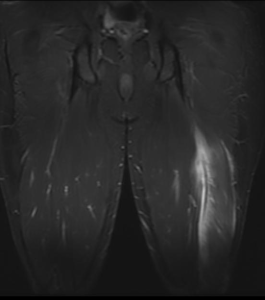Have you ever heard of snapping scapula syndrome? If you answered no, I would not be too surprised. Whilst this condition is more common than you may think, it seems to be underappreciated within the physiotherapy. Thus, this article will discuss snapping scapula syndrome including what it is, why it occurs and what you need to do to fix it!
Ankle sprains are very common in the practice of sports physiotherapy. However, unfortunately many patients go on to have long term problems. This has lead to the development of many proposed treatments and rehabilitation programs. This article will discuss new research into the use of manual therapy techniques combined with exercises for the rehabilitation of inversion ankle sprains.
Many sports physiotherapists rehabilitate hamstring injuries on a daily basis. Unfortunately, they can be very tricky to fully and definitively rehabilitate fully and reported re-injury rates are as high as 50%. This statistic inevitably leads to the people screaming it is due to inadequate rehabilitation techniques, which may be correct. Accordingly, this article will discuss new research which compares the clinical and morphological effects of 2 effective rehabilitation programs for hamstring injuries.
Now, we have discussed Arnold Schwarzenegger on this site before, in a post about the psychology of sports injury and physiotherapy. However, it seems that man was quite the insightful gentleman. In his text The Encyclopedia of Modern Bodybuilding Arnold discusses the mind to muscle connection and the importance of not just lifting a weight up and down, but having your “mind in the muscle”. This article will discuss new research into conscious correction of scapular position.
Aerobic exercise, particularly in the form of running, has become more popular with the general population over the last few decades. Unfortunately, this increase in healthy exercise may come at a cost with up to 80% of runners reporting a lower limb injury. These trends mean that preventing running injuries is gaining significant importance in the world of sports medicine. One touted intervention that is currently in vogue is adapting the runner’s biomechanics to a forefoot strike pattern or barefoot running technique…
Introduction Hamstring strains are commonly assessed and treated in the world of sports physiotherapy. They represent the most common injury in a number of sports, including AFL and soccer, accounting for up to 12-16% of injuries (Hawkins et al., 2001; Warren et al., 2010). Dvorak and Astrid (2000) suggested that hamstring injuries occur at an […]
How regularly do you treat injured athletes with reduced lower limb flexibility? The answer from many of you would likely be all day long! It has been well established that athletes with reduced lower limb flexibility are at greater risk of injury (Murphy et al., 2003). Thus, it would be logical that a program of regular stretching, which has been shown to improve lower limb flexibility (Harvey et al., 2002), would reduce this injury risk… wouldn’t it? Well, not conclusively…
Introduction The condition discussed in this article, you will come to find, is quite complex and can be a battle for the physiotherapist and physical therapist. Thoracic outlet syndrome is considered to be a collection of quite diverse syndromes rather than a single entity (Yanaka et al., 2004), and therefore, accurate diagnosis and enlightened treatment […]
It is no secret that sports physiotherapists and physical therapists across the world commonly assess and treat knee injuries. Of these injuries, patellofemoral pain is exceptionally common, accounting for 25% of all sports related knee injuries (Fredericson & Yoon, 2006). In fact, patellofemoral pain syndrome is the most commonly reported injury sustained by runners (Taunton et al., 2002). As many of the aetiological factors that contribute to patellofemoral pain syndrome have not been clearly identified, decision making regarding appropriate rehabilitation and treatment can often be challenging. This article will discuss the use of isometric adduction during closed kinetic chain lower limb exercises to facilitate vastus medialis obliquus (VMO) activation.
As sports physiotherapists we treat all sorts of patients that want to do crazy things. You know… run, swim and ride all day and even climb mountains and cliffs. Many of these athletes are young and physically active, and they strive to push their body to its physical limits. A well recognised condition to affect this group of people is chronic exertional compartment syndrome (CECS). In fact, eighty-seven percent of patients with CECS participate in sports, and runners account for 69% of these cases Thus, sports physiotherapists, particularly those that deal with endurance sports, will assess and treat this condition with considerable frequency. This article discusses new research on changing biomechanics to manage CECS.
In the past this site has featured some lighter, colloquial blog posts. These articles discuss issues related to the greater physiotherapy community. Thus, I present a few mantras I have heard, adapted or made up for the physios to live by in the coming year.
Radial tunnel syndrome is rare, it is challenging to differentially diagnose and can be a monster to manage. If you have a recalcitrant case of tennis elbow then this post will interest you! This article discusses the best available evidence for assessment and management of radial tunnel syndrome.








